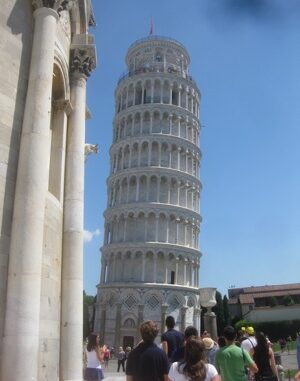
Pisa is famous for its bell tower that went a bit wrong. Which is odd as generally humans like perfection and travel miles to see things done well. We can all, one might think, construct a leaning tower at home with an Architecture-for-beginners book and a JCB. It’s a tower that stands perfectly upright that is the hard one. Nevertheless Pisa’s campanile has been decreed a tourist attraction and people come to look at it and say wow.

There’s no denying it leans. It has done since almost the very beginning. The top floors were actually built at a slight angle to the bottom ones to counteract the lean that had started before the tower was even finished.
But there is more to Pisa than the leaning tower. There is more to the Piazza dei Miracoli than the leaning tower. The whole Piazza is a UNESCO World Heritage Site. As well as the Tower there is the Cathedral, the Baptistry and the cemetery. All three add to the ambience and beauty of the walled Piazza.
1. Il Duomo
Work on building the Duomo started in 1063. That’s a long time ago – even if it didn’t look spectacular people would be impressed. But it does look spectacular, a marvel of glinting marble rising out of one of the greenest cathedral closes in Italy. Buscheto was the architect, and he developed the Pisan Romanesque style, his use of pointed arches and interior mosaics demonstrating a heavy Byzantine influence.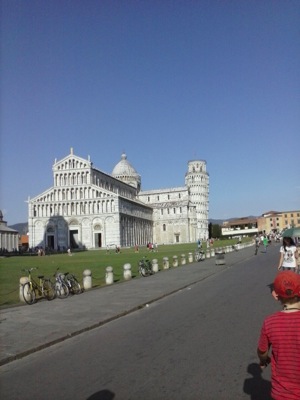
Inside the Duomo is a stunning pulpit sculpted by Giovanni Pisano between 1302 and 1310. It has delicate carved scenes from the New Testament around the top and sits on plain columns and caryatids.
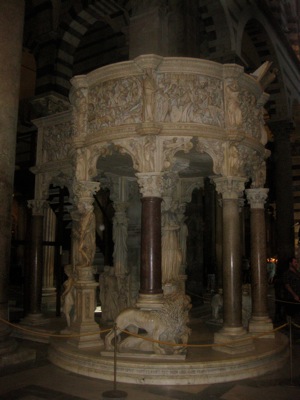
Like the Tower the Duomo leans. This is not as pronounced as the tower and is not a danger.

2. The Pisa Baptistry
The Baptistry at Pisa was begun in 1152 by the architect Diotisalvi. It is circular, with a circumference of 107metres. It is a good example of the change from Romanesque to Gothic styles – the lower decorations are circular arches whilst higher up they change to Gothic, pointed versions.
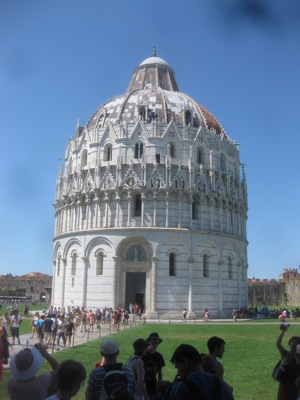
The interior is unexpectedly plain. However it has superb acoustics. Every half an hour during the day a man comes in and demonstrates the sound reproduction qualities of the space by singing with his own echoes. A short, unusual performance that is well worth hearing.
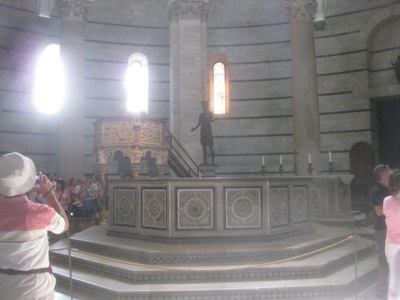
The Baptistry includes a massive pulpit sculpted by Nicola Pisano around 1255. Nicola was the father of Giovanni who sculpted the pulpit in the Duomo. His depictions of characters on the pulpit began a return to naturalism that anticipated the Early Renaissance that was to follow. He also finished the design of the baptistry after the original architect died, adding a cupola rather than the planned pyramidal roof.

3. The Cemetery
The Cemetery dates from 1278 although it was only finished in 1464. It is said to have been built on soil brought back from Golgotha after the fourth crusade in the 12th century. Taking the form of a Gothic cloister the cemetery lies to the north of the Duomo and the tower. It has a rose garden and lawn in the centre and broadcasts a sense of contemplation and quiet after the hubbub of the tourists in the Piazza.

Originally most of the walls would have been frescoed. Now only a few remain. Many were destroyed during the second world war when the leaded roof caught fire.

Many Roman sarcophagi line the cloisters, no doubt reused since the original owners first took possession.
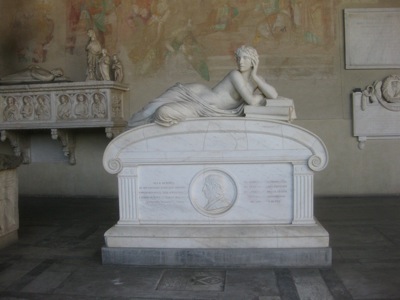
There are some outlandish designs on the gravestones that make up parts of the floor.

There are also the remains of the chains used to block the Pisan port. These were taken by the Genovese in 1342 and only returned in 1860!

4. Il Torre Pendente – the leaning tower of Pisa.
You may have heard that there is a tower in the Piazza. You probably know it leans a bit. Closed throughout the 1990s it has been stabilised to an angle of 4 degrees and is now safe to climb up. The engineers could have corrected the tilt entirely, but the lean was kept. Built in stages between 1173 and 1372 the leaning began only five years after building started. Undeterred the locals left it a hundred years and then carried on. Sixty metres high, it gives a stunning view over the Piazza and the rest of Pisa.


It is recommended to get tickets for the tower online before you get to Pisa. You can do this here:

Leave a Reply